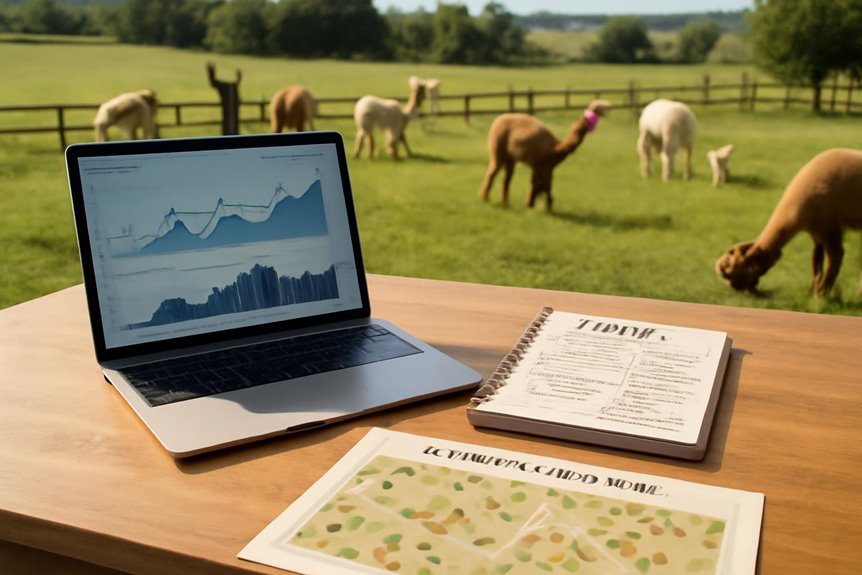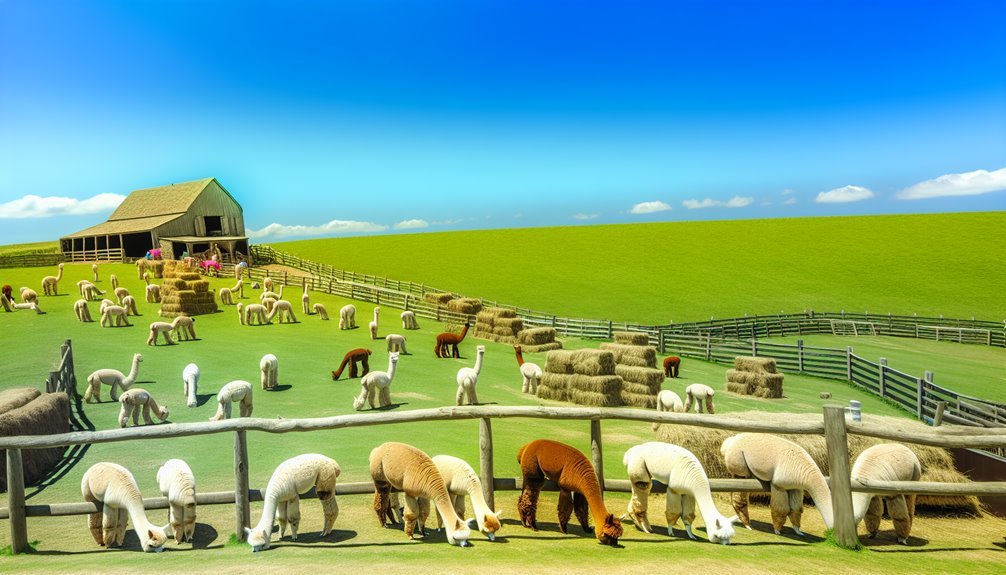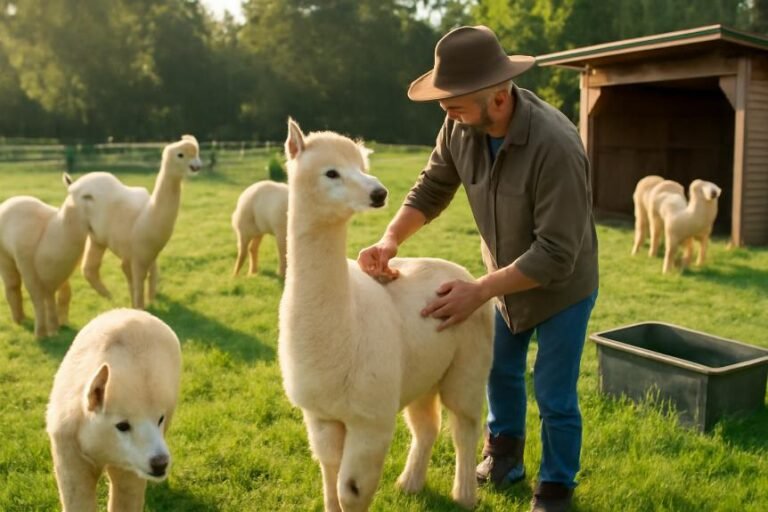Alpaca Farming Business Plan Guide for Success
To succeed in alpaca farming, you’ll need clear goals balancing short-term wins and long-term growth, backed by solid market research on customers and competitors. Plan detailed finances covering startup and operations, plus legal steps like zoning compliance and licenses. Build your farm’s infrastructure with shelter, fencing, and grazing plans while focusing on animal welfare. Establish marketing, partnerships, and sustainable practices to boost profits and brand strength. Keep exploring to uncover strategies that guarantee lasting success in this unique business.
Key Takeaways
- Set SMART business goals balancing short-term revenue and long-term profitability from fleece, breeding, and agritourism activities.
- Conduct thorough market research to identify target customers, analyze competitors, and develop a unique value proposition with tailored marketing.
- Prepare detailed financial projections including startup costs, operating expenses, and five-year profit forecasts; ensure compliance with legal and zoning requirements.
- Plan infrastructure with adequate shelter, secure fencing, rotational grazing, and sustainable practices to maintain animal welfare and farm productivity.
- Build industry partnerships, join alpaca associations, and engage in marketing and distribution to expand network and enhance farm success.
Defining Clear Business Goals and Objectives

Setting clear business goals and objectives is essential for your alpaca farming success. Your business plan should establish SMART goals to provide a focused roadmap, balancing short-term objectives like acquiring alpacas or building infrastructure with long-term goals such as profitability within a few years. Incorporate revenue generation targets from fleece sales, breeding, and agritourism to diversify income. Also, plan for operational expenses to maintain financial health. Marketing plans must align with these goals to reach your audience effectively. Regularly review and adjust your goals based on performance and market shifts to stay competitive. By defining clear, measurable objectives, you’ll guarantee your alpaca farming venture remains focused and adaptable, setting a solid foundation for sustainable growth and success.
Conducting Comprehensive Market Research
To succeed in alpaca farming, you need to understand who your target customers are and what they value most. Evaluating your competitors will also help you spot opportunities to stand out with quality products or unique branding. Using reliable market data can guide your strategy and keep you ahead in this growing industry.
Target Market Analysis
A thorough target market analysis starts with gathering direct feedback from your community through surveys or focus groups, both locally and online, to understand who’s interested in alpaca products and what they prefer. By analyzing consumer behavior on social media and forums, you can spot trends and preferences, especially the growing demand for sustainable products in the alpaca industry. Use industry reports to review revenue projections and identify valuable growth opportunities. Understanding the target market helps shape effective marketing strategies tailored to eco-conscious buyers seeking alpaca fiber goods. This research guarantees your business meets customer needs and capitalizes on market gaps, setting a solid foundation for success in alpaca farming.
Competitor Landscape Evaluation
Understanding your target market is only part of the equation; knowing who you’re up against completes the picture. To evaluate the competitor landscape, analyze existing alpaca farms near you, focusing on their market positioning and pricing strategies. Visit local shows and farms to observe competitors’ product quality and customer engagement firsthand. Use online industry reports to identify market trends and potential gaps in revenue streams. Study competitors’ marketing strategies, including their social media and customer feedback, to craft a unique value proposition that sets you apart. Assess their pricing structures carefully to guarantee your products remain competitive yet profitable. This thorough research will help you develop effective marketing strategies that attract customers and strengthen your foothold in the alpaca farming business.
Developing Detailed Financial Projections
Although alpaca farming involves significant initial investment, developing detailed financial projections will help you manage costs and forecast profitability effectively. To build sound financial projections, focus on these critical areas:
Creating thorough financial projections is essential for managing costs and ensuring alpaca farming profitability.
- Startup costs: Include expenses like land, shelter, fencing, and quality breeding stock, which can range from $50,000 to $100,000 depending on your scale and location.
- Operating expenses: Estimate annual costs for feed, veterinary care, and maintenance, averaging $1,500 to $3,000 per alpaca.
- Revenue streams: Project fleece sales, considering each alpaca produces 2–5 kg annually, with high-quality fleece selling for $2 to $4 per ounce.
Create a five-year profit and loss projection to assess profitability and aim for a return on investment within 2–3 years. Tracking cash flow carefully guarantees you account for seasonality and cost fluctuations in your alpaca farming financial projections.
Creating an Effective Marketing Strategy
Once you’ve mapped out your financial projections, it’s time to focus on getting your alpaca products noticed. As alpaca farmers, understanding consumer preferences through thorough market research helps you tailor your marketing channels effectively. Build a strong brand identity emphasizing quality and sustainability, guaranteeing it’s consistent across social media, your website, and promotional materials. Use digital marketing strategies like SEO to boost your online visibility. Engage your audience on social media by sharing engaging alpaca photos and videos, fostering community interaction. Additionally, implement email marketing campaigns to keep customers informed about new products, promotions, and farm events, encouraging repeat business. Combining these approaches guarantees your marketing efforts resonate and grow your alpaca farming venture successfully.
Securing Funding and Managing Finances

Before launching your alpaca farm, you’ll need to secure funding by exploring options like bank loans, angel investors, and government grants. A solid business plan is essential—it should clearly outline your concept, target market, financial projections, and growth strategies to attract investors. Next, estimate your startup costs, including land, fencing, shelters, and breeding stock, plus operational expenses like feed and veterinary care. Develop a financial model that projects profitability by analyzing revenue streams such as fleece sales, breeding services, and value-added products. To manage your finances effectively:
- Identify and compare various funding sources to find the best fit.
- Detail startup costs and ongoing operational expenses in your business plan.
- Monitor financial performance regularly to stay on track toward profitability.
This approach guarantees your alpaca farm’s financial health and long-term success.
Navigating Legal Requirements and Compliance
Before you start your alpaca farm, make sure you understand local zoning laws to confirm your property allows livestock and breeding. You’ll also need to complete the business registration process to operate legally and avoid fines. Staying on top of these requirements sets a solid foundation for your farm’s success.
Zoning Laws Compliance
Although zoning laws might seem complex, understanding and complying with them is essential if you want to run a successful alpaca farm. You need to start by verifying local zoning and agricultural zoning laws to guarantee your property can legally house alpacas. Next, familiarize yourself with regulations regarding land size, shelter needs, and proximity to neighbors, as these impact your operations. Finally, obtain all necessary permits and licenses, including those related to breeding, waste management, and animal care standards.
Here are three steps to guarantee compliance:
- Contact your local zoning board or agricultural office for detailed compliance requirements.
- Review permits and licenses specific to alpaca farming.
- Avoid non-compliance to prevent fines, delays, or forced shutdowns.
Following these steps keeps your farm legally sound and thriving.
Business Registration Process
Once you’ve confirmed your alpaca farm complies with zoning laws, the next step is registering your business properly. Start the business registration process by forming a Limited Liability Company (LLC) to protect your personal assets and add credibility. You’ll need to submit articles of organization to your state. Next, obtain an Employer Identification Number (EIN) from the IRS; this is essential for tax purposes, opening a business bank account, and securing permits and licenses. Be certain to register for all required permits and licenses specific to your state or locality, including any sales tax licenses if you plan to sell products. Finally, consult a farm accountant to maximize tax deductions and guarantee compliance with agricultural tax rules. This legal groundwork sets your alpaca farm up for long-term success.
Planning Infrastructure and Farm Operations
When you’re planning infrastructure and farm operations for your alpaca business, providing adequate shelter and secure fencing is essential to keep your animals comfortable and safe. Each alpaca needs 10–12 square feet of shelter space to protect against harsh weather, while woven wire fencing, 4–5 feet high, keeps them secure from predators and prevents escapes. Beyond shelter and fencing, focus on efficient farm operations by:
- Designing designated areas for shearing and fleece storage to maintain quality and streamline production.
- Implementing rotational grazing practices to sustain pasture health and optimize alpaca nutrition.
- Establishing a manure management system to maintain cleanliness and minimize environmental impact.
Proper infrastructure and thoughtful operations create a thriving alpaca farm, ensuring your animals’ welfare and long-term business success.
Building Partnerships and Industry Networks
Since alpaca farming involves more than just raising animals, building strong partnerships and industry networks is critical to your success. By joining alpaca associations and industry networks, you gain access to valuable knowledge and collaboration opportunities. Attending trade shows helps you stay updated on market trends and connect with fellow farmers and experts. Building partnerships with local artisans and fashion designers can boost your brand visibility by combining craftsmanship with high-quality fleece. Expanding your distribution channels through relationships with retailers and online platforms increases your sales potential. Additionally, engaging in research collaborations with educational institutions promotes innovative practices in alpaca care and product development. These connections not only enhance your farm’s growth but guarantee you remain competitive and informed within the alpaca industry.
Implementing Sustainable Growth Strategies

Building strong industry connections lays a solid foundation, but sustaining growth requires strategies that protect your resources and improve efficiency. In alpaca farming, focusing on sustainable breeding enhances fiber quality and genetic diversity, ensuring herd health and market appeal. To implement sustainable growth, consider these key actions:
- Adopt rotational grazing to maintain pasture health, boost soil fertility, and cut feed costs.
- Invest in renewable energy like solar panels to lower utility expenses and strengthen your farm’s eco-friendly profile.
- Create value-added products by partnering with local artisans, diversifying income while meeting evolving market trends.
Regularly review your practices to align with environmental impacts and market demands, keeping your alpaca farm competitive and sustainable for the long term.
Frequently Asked Questions
How Profitable Is Alpaca Farming?
You’ll find alpaca farming profitable if you manage herd management well, optimize breeding strategies, and control operational costs. With strong market demand for alpaca fiber and sustainable practices, your investment returns can be quite rewarding over time.
How Much Does It Cost to Start an Alpaca Farm?
Imagine you want to start an alpaca farm; your initial investment might hit $75,000, covering land acquisition, equipment expenses, feed requirements, veterinary care, and breeding expenses. These start up costs are essential for success.
How Many Acres for 3 Alpacas?
You’ll need about 1 to 2 acres for 3 alpacas to guarantee proper pasture management and alpaca care. This supports feeding guidelines, health monitoring, shelter needs, fencing requirements, and breeding practices without overcrowding stress.
What Are the Disadvantages of Raising Alpacas?
You’ll face health challenges and breeding difficulties, plus significant initial investment and space requirements. Market competition can be tough, fiber quality varies, and the time commitment is high. Managing all this demands dedication and smart planning.








Our picks
Alpaca & Wool Felted Sole Inserts: Comfy Upgrade?
Best Alpaca Socks for Hiking: Ultimate Comfort and Durability on Trails
Best Alpaca Halter for Comfort and Control